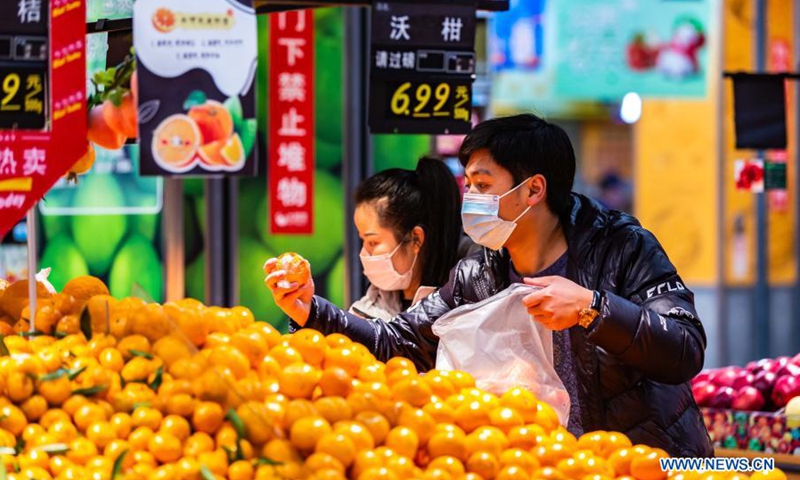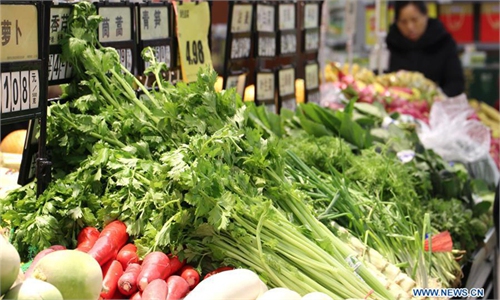
People select food at a supermarket in Xixiu District of Anshun, Southwest China's Guizhou Province. File Photo: Xinhua
China's consumer prices rose by a moderate 0.9 percent year-on-year in 2021, official data showed on Wednesday. The reading provides a solid base for China's steady economic growth and serves as a stabilizer for the global economy facing downward pressure, experts said.
The consumer price index (CPI) rose 1.5 percent in December, while factory gate prices as measured by the producer price index (PPI) surged 10.3 percent, although both rates edged down from the November figures, according to official data released by the National Bureau of Statistics (NBS) on Wednesday.
The consumer market was steady in December due to coordinated measures to stabilize supply amid recent outbreaks of COVID-19 across multiple Chinese cities, Dong Lijuan, a statistician from the NBS, said on Wednesday.
Dong said that the main source of the CPI slowdown was a significant fall in food prices, particularly pork.
According to the NBS data, pork price dropped 36.7 percent year-on-year in December, widening four percentage points from November. Overall, food prices flipped from 2.4 percent growth in November to a decline of 0.6 percent in December, contributing about 0.1 percentage points to the CPI's slowdown on a monthly basis, Dong said.
In comparison, the PPI rise was 1.2 percentage points less than in November, due to a fall of major industrial products as stabilizing policies took effect, according to the NBS. In 2021, the PPI rose 8.1 percent over the previous year.
According to NBS data, coal prices continued to fall in the second half of last year. Price for steel, cement and other building materials dropped due to weaker winter demand.
It is expected that the PPI will edge down in 2022 while the CPI will rise slightly. The overall increase will be moderate and there will be no inflationary pressure in China, Liu Xuezhi, a senior macroeconomics expert at the Bank of Communications, told the Global Times on Wednesday.
The moderate increase of the CPI at 0.9 percent during 2021 and the growth of the PPI at 8.1 percent have laid a solid foundation for steady GDP growth, analysts said.
As 2021 drew to a close, most economists and institutions announced their estimates for China's GDP growth this year, which ranged from 8.0-8.5 percent, higher than the target of "above 6 percent" set by China's central government and also higher than the majority of other economies.
China's GDP is estimated to have grown 8 percent in 2021 versus 5.6 percent for the US and 5.5 percent for the world, according to the World Bank's latest Global Economic Prospects report released on Tuesday.
The report highlighted that the global outlook is "clouded by various downside risks," including renewed COVID-19 outbreaks, the possibility of unanchored inflation expectations, and rising debt levels faced by many countries.
Chinese GDP growth is estimated to slow to 5.1 percent this year while the US growth rate is estimated to moderate to 3.7 percent this year.
The adjustment is reasonable, based on fresh threats from COVID-19 variants to major economies, however, in the long run, China's growth expectations are better than those of the US, Li Haidong, a professor from the Institute of International Relations of the China Foreign Affairs University, told the Global Times on Wednesday.
China's inflation showed that the fundamentals of consumption and the economy are healthy in China. In comparison, the December CPI of the US is estimated at 7 percent, showing that the US is facing a serious inflationary pressure since the Cold War, Li said.
"The problems in the US include the uneven distribution of wealth, high debt, high distribution of dollars and a confrontation with global economic integration, which has caused lasting dissatisfaction within the nation and disturbed the global economy," Li said.
In comparison, China's deployment of dual circulation policies with a focus on the domestic market showed that it has sufficient policy tools to deal with external risks, Li noted.
The diversity of domestic products and the nation's consumption potential are expected to benefit other countries and make China a stabilizer of the global economy, he noted.
Wu Chaoming, chief economist at Chasing Securities, said that Chinese macro policy in 2022 will focus on driving up domestic demand in terms of infrastructure investment, real estate investment and consumer demand.
It is estimated that China's economic growth will be about 5.5 percent in 2022, rising stably in each quarter with the three-year compound average growth rate in 2020-22 at about 5.2 percent, Wu said.
Wu said that the Chinese government would likely step up policy support this year to prop up market demand, including reducing interest rates.

